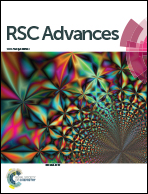Hydrogen-bond acidic polymers coated SAW sensors for 2,4-dinitrotoluene detection
Abstract
Two strong hydrogen-bond acidic (HBA) polymers DKAP and PLF, were coated onto 434 MHz surface acoustic wave (SAW) devices for rapid detection of an explosive compound, 2,4-dinitrotoluene (2,4-DNT). Sensitivity and selectivity of the polymer-coated sensors were studied by exposure to 2,4-DNT in the concentration range of 200 ppb to 1 ppm, as well as some common interferences at higher concentrations. The results showed that the DKAP sensor has a 4.6 times higher sensitivity to 2,4-DNT than PLF at the concentration of 1 ppm, while a further comparison indicated that their sensitivities to dimethyl methylphosphonate (DMMP) are essentially identical. The superior sensitive performance of DKAP to nitroaromatics as compared to PLF can be attributed to the dipolarity induced by the aromatic ring segments, which promotes π–π interactions between the explosive vapor and the polymer coating. In addition, the DKAP sensor exhibits a high response of 4.6 kHz to 200 ppb 2,4-DNT, with an extrapolated limit of detection (LOD) of 0.1 ppb, which is comparable to most sensitive polymer-coated sensors previously reported. Furthermore, both adsorption and recovery time of the DKAP sensor is much shorter than other related sensors. Sensor responses to possible common interferences are found to be 11–35 fold lower than to 2,4-DNT. In situ infrared spectroscopy studies were performed to demonstrate the hydrogen bonding between nitroaromatic compounds and the chemoselective polymers.


 Please wait while we load your content...
Please wait while we load your content...